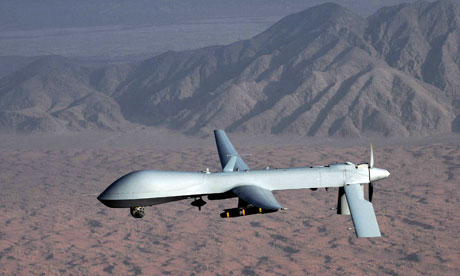Drones can be used by Nato forces in Libya, says Obama
Senior Nato military commanders have been pressing for the unmanned US planes to strike Gaddafi forces in besieged Misrata

Precision targeting provided by unmanned drones has become a favoured strike weapon in Afghanistan, and could help Nato pinpoint Gaddafi forces in Libya. Photograph: Sipa Press/Rex Features
The White House has approved the use of missile-armed Predator drones to help Nato target Colonel Gaddafi's forces in Libya.
Coalition commanders have been privately urging the Americans to provide the specialist unmanned aircraft, which have become a favoured – if controversial – weapon in Afghanistan and Pakistan.
Their ability to hone in on targets using powerful night-vision cameras is considered to be one way of helping rebels in the besieged city of Misrata, where a humanitarian crisis has unfolded in the last week.
The US defence secretary, Robert Gates, said Barack Obama had approved the use of the Predators which are armed with Hellfire missiles, marking a marked growth in the US contribution to the Nato effort.
Gates told a Pentagon news conference that the Predator was an example of the unique US military capabilities that the president is willing to contribute while other countries enforce a no-fly zone.
General James Cartwright said that the first Predator mission in Libya had been scheduled for Thursday night but was abandoned because of poor weather. The US military plans to maintain two patrols of armed Predators above Libya at any given time, permitting better surveillance – and targeting – of Gaddafi's forces as they dig into positions next to civilian areas, Cartwright told the same briefing.
The drones are based in the region but typically flown via remote control by pilots in the US. The drones for Libya had not been withdrawn from Afghanistan, Gates and Cartwright said.
Khaled Kayim, Libya's deputy foreign minister, said the deployment of the drones would result in the deaths of more civilians. He described the move as "undemocratic and illegitimate and I hope they will reverse their decision".
Liam Fox, the British defence secretary, and Sir David Richards, the chief of the defence staff, are due in Washington next week to discuss the situation in Libya.
The use of Predators is one of the topics to be discussed at the Pentagon talks next Tuesday, as well as other specialist equipment that might be provided by the US.
David Cameron has again insisted that Nato had no intention of deploying ground troops, but that did not mollify Russia. It condemned the sending of military advisers to Libya by the UK and France, saying it exceeded the mandate of UN security council resolution 1973. "We are not happy about the latest events in Libya, which are pulling the international community into a conflict on the ground," said the Russian foreign minister, Sergei Lavrov."This may have unpredictable consequences," he added.
But senior Whitehall officials believe the use of drones, also known as UAVs, would not be beyond the remit, or the spirit, of the UN resolution which gave the coalition a mandate to protect civilians. "A UAV with sufficiently high-resolution sensors, were it armed, could fire that weapon in line of sight and still meet the tight rules of engagement," a Whitehall source said.
"We have been asking if we can get the US to provide that capability for us. It exists – the question is can we get it to be deployed? UAVs would give you speed of response where you see the regime transgressing the UN resolution," the source said. The US is understood to have the UAVs in the region already.
Gates said Obama continues to be opposed to sending US ground forces into Libya and there were no plans to send US trainers to augment Nato forces already working with rebel forces. "There's no wiggle room in that," Gates said.
The UN secretary general, Ban Ki-Moon, urged Gaddafi to "stop killing people", and estimated that 500,000 Libyans had fled the country. The MoD also sought to counter criticism Nato is not doing enough for Misrata, saying the RAF had hit 58 targets around the city in the past three weeks, including 37 main battle tanks. But officials concede the difficulties of targeting within the city are considerable.
Earlier this week Nato's commander, Lt Gen Charles Bouchard, described the situation within Misrata as being akin to "a knife fight in a phone booth". He said Gaddafi forces were hiding on the rooftops of mosques, hospitals and schools, and that they were shielding themselves behind women and children.
The military difficulties were underlined when further details emerged of the death of British photographer Tim Hetherington, who was killed on Wednesday in a mortar attack along with a colleague, Chris Hondras. An Oscar-nominated filmmaker, Hetherington, 41, wrote in his last Twitter post on Tuesday: "In besieged Libyan city of Misrata. Indiscriminate shelling by Gaddafi forces. No sign of Nato." Vanity Fair editor Graydon Carter said Hetherington was "about as perfect a model of a war photographer as you're going to find these days".
No comments:
Post a Comment